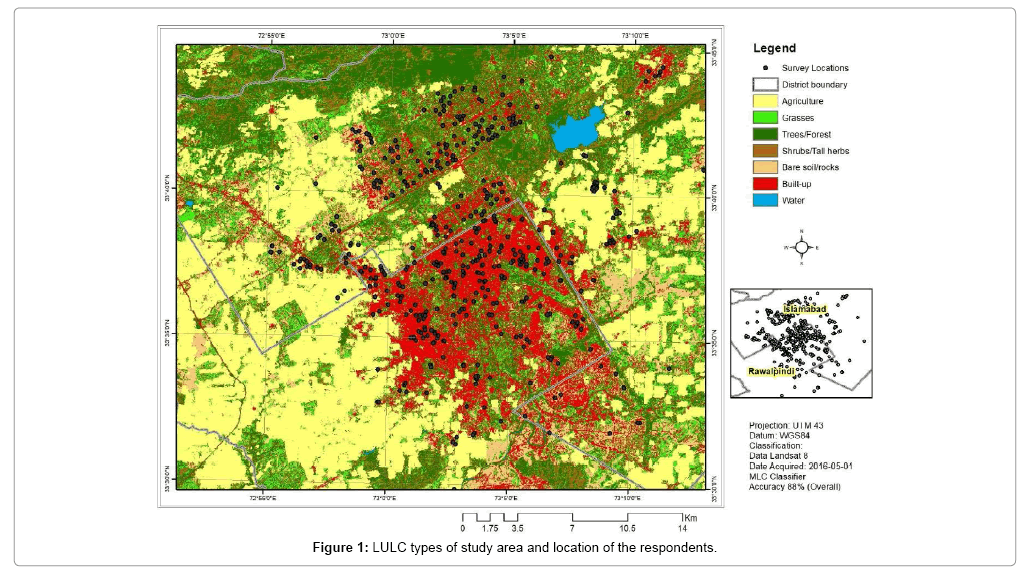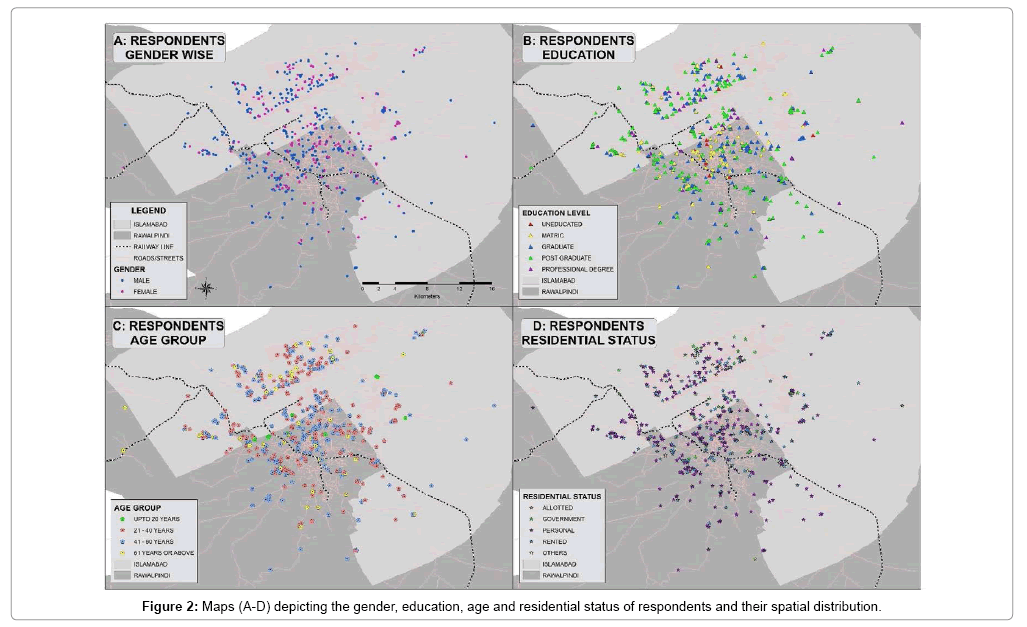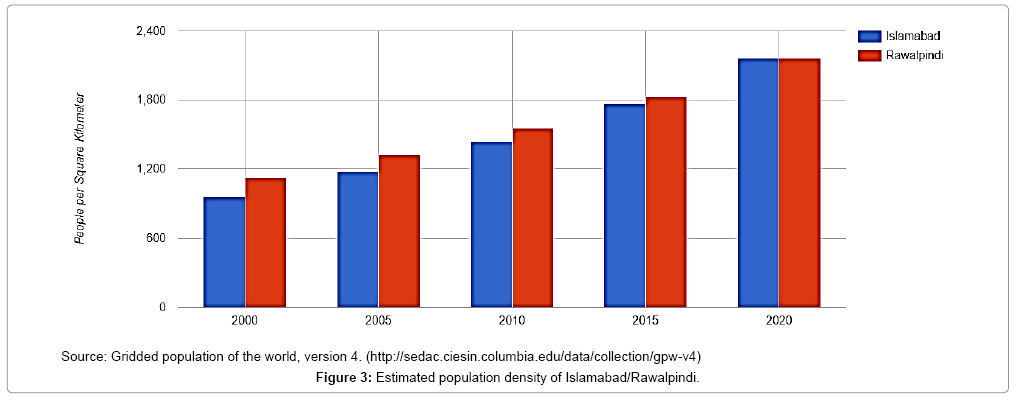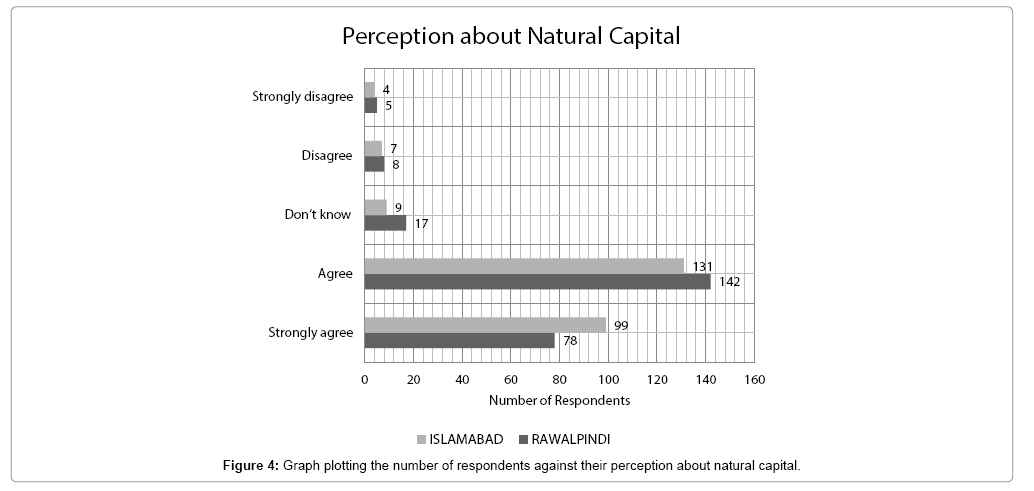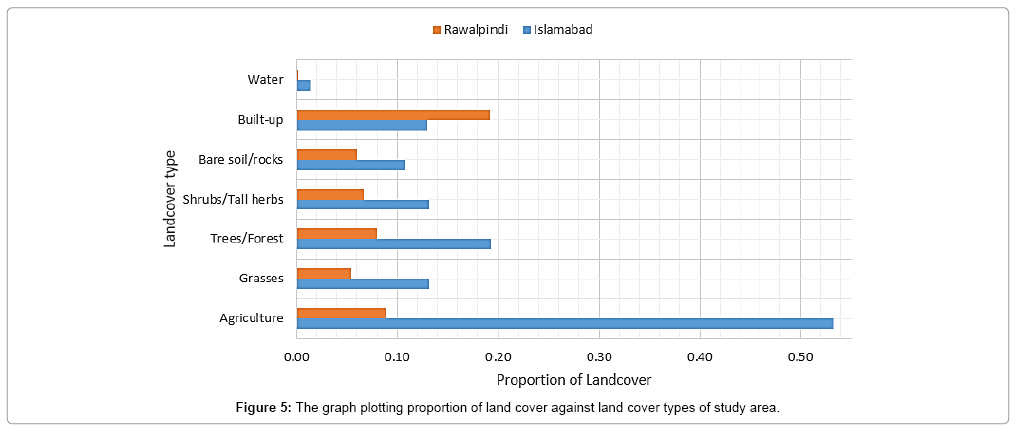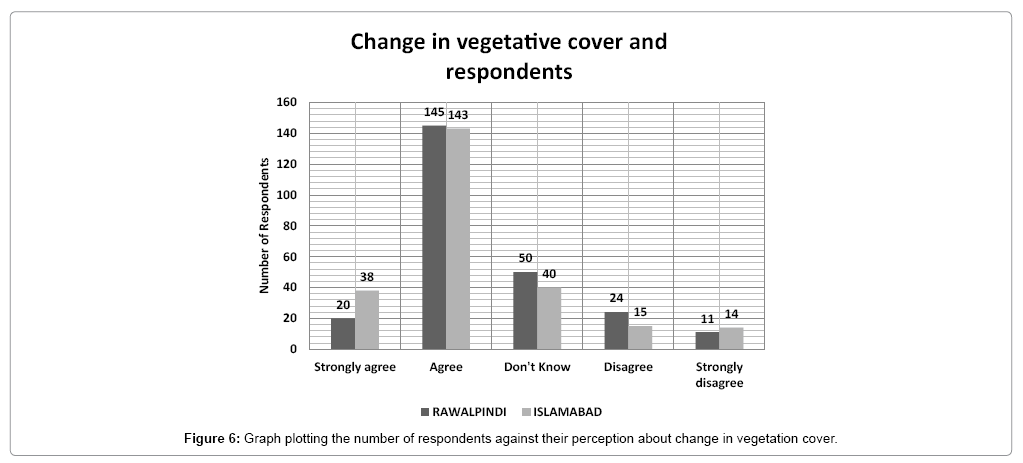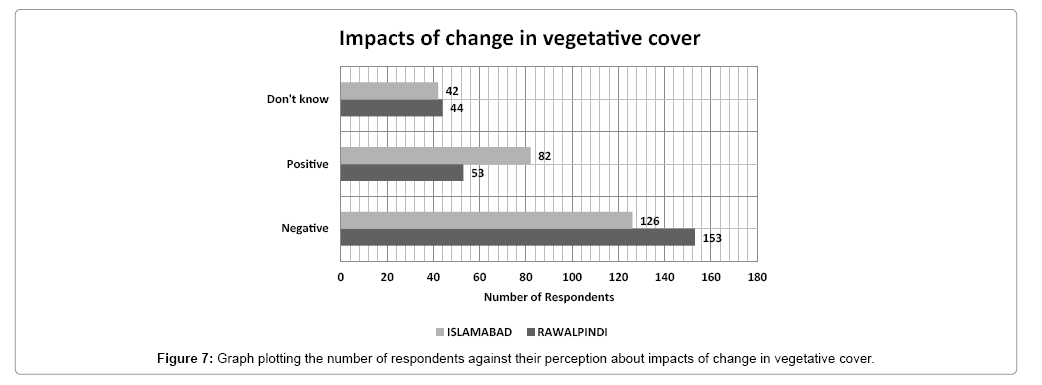Perception of Residents about Urban Vegetation: A Comparative Study of Planned Versus Semi-Planned Cities of Islamabad and Rawalpindi, Pakistan
Received: 01-Feb-2018 / Accepted Date: 19-Feb-2018 / Published Date: 28-Feb-2018 DOI: 10.4172/2157-7625.1000251
Abstract
The present study compared opinions of south Asian planned (Islamabad) versus semi-planned (Rawalpindi) urban residents, regarding urban vegetation (ecological capital) and its usefulness. These urban areas known as twin cities lie in close vicinity but their contrasting contextual setting makes them a suitable case study. The locals were asked questions related to the importance of urban vegetation, changes in it over a period of time and resultant impacts (positive/negative). A majority (90%) of respondents opined that urban vegetation is beneficial while another big proportion (69.20%) believed vegetation cover changed over time and recent changes in urban vegetation were viewed negatively (55.80%). Statistical analysis revealed that respondents form both cities significantly differ in their point of view regarding ecological capital: usefulness of vegetation (p<0.02); urban vegetation cover changes (p<0.02) and its impacts (p<0.01). The study concluded that planning/contextual settings influence human perception about natural capital in urban settings. While, the people were equivocal in perceiving the vegetation change; the negative impacts were more felt by the people living in semi-planned area than the people living in the planned areas.
Keywords: Ecosystem; Urban vegetation; Sustainability; Semiplanned
Introduction
Human perception about natural environment and the urge to contribute towards its sustainability are influenced by societal norms and the awareness pertinent to the benefits of environment [1-3]. These benefits are referred to as ecosystem services [4-8]. The previous findings postulated a positive correlation between healthy ecosystems and the quality of human life [8-11]. This significant link demands a more intensive and extensive assessment of the ecosystem services [12-14]. The research orientation for understanding the intricate relationship between man and natural environment, in diversified contextual settings, is gaining momentum [4,7]. The findings of recent studies also stressed upon the identification of factors needed for social support to achieve the goal of urban environmental sustainability [1,15-22].
The proportion of global population living in urban areas is increasing [8,9,23-25] along with the consequential impacts of urbanization on climate, biodiversity and ecosystem [8,19,23,26-30]. Ostensibly, it seems that environmental sustainability and urbanization are self-contradictive to each other [8]. Synchronization of these two realities is, thus , the ultimate challenge [31,32]. This synchronization will go a long way in achieving the objectives of social, ecological and environmental sustainability in a given urban milieu [22,33]. The assessment of perception among people about green capital i.e., ecological resources, between planned and semi planned urban areas is important for ensuring integrated management of ecological resources in urban areas [1,34,35].
The recent wave of uncontrolled urbanization in developing economies is making their ecological resources more vulnerable [24,25,28,31,36,37] due to their lack of preparedness and limited response options in the wake of global climatic changes. The depreciation of ecological resources in these regions, ultimately, hit the economically deprived sections of society very hard [38,39]. These sections are least responsible for this deteriorating scenario, yet they have had to bear the brunt of its effects. It is being opined that the ecological foot-prints of these urban areas will increase in magnitude [25,26,28], and intensify with the expansion in physical size and functional heterogeneity of these urban settlements [40].
Pakistan is the region where the phenomena of permanent settlement had taken place thousands of years ago during the phase of the Indus valley civilization [41]. During the course of time, a varied set of factors contributed towards population growth such as canalization of the Indus plains. The green revolution of 1960s and the industrial initiatives of the subsequent years further accelerated the phenomenon. The resultant socio-economic transformation and fragmentation of rural society manifested itself in the form of rural to urban migration.
The research findings support the notions that in the future, the process of urbanization will further accelerate in developing countries such as Pakistan [26,42,43]. The resultant unprecedented urbanization in these countries is now visible in the form of urban sprawl and vertical expansion of the cities [28]. Unfortunately such urban expansions/urban renewals are not supported by the poorly planned civic infrastructure, ineffective urban management, lack of vision and compromises over polices in the developing world [28,31]. These stressors further exacerbate the performance of already threatened ecological capital of urban areas in less developed regions of the world [28,44].
The ecological degradation in urban areas demands the restoration, preservation and enhancement of ecological resources for ecological integrity and social sustainability [19,23,28,31,45,46]. However, this is one of the missing links in the field of urban policy and planning in a country like Pakistan. Systematic information about human perception gives the right orientation for understanding the factors affecting ecosystem resilience in an urban setting [1,47]. Thus, a scientifically investigated framework is a prerequisite for the comprehensive assessment of eco-capital in consultation with the relevant stakeholders [1,22,48].
Pakistan can be listed among the countries where the scientific research for understanding the role of ecosystem services is still in its infancy but at the same time it is imperative to address the rapidly declining state of urban ecological health [24,49].
The orientation towards UES research started to develop in Pakistan during the last decade. During the course of this time, studies were designed for evaluating such factors as: the perception of people about urban green spaces [50], deciphering the impacts of urban renewal on vegetative cover [51], weighing the contribution of urban green spaces in social life [28,52] and identifying socio-ecological barriers concerning the use of green spaces in the coastal urban settings of Karachi [28]. However, the physiographic, climatic, ecological, demographic, economic and functional characteristics of Karachi are inherently different from the urban centers of Pakistan located in the Himalayan piedmont such as Islamabad and Rawalpindi.
In this connection, the studies were carried out in in the contextual urban setting of Islamabad/Rawalpindi for assessing vegetative diversity [53], deciphering the interrelationship between urban vegetation and soil properties [54] classifying the vegetative communities [55] and evaluating the contribution of floristic resources in urban social life as well [56]. The studies carried [57,58] were designed to predict scale, speed and pattern of urbanization in Islamabad and for assessing its consequential impacts on natural environment. The studies also focused on the impacts of Land Use/Land Cover Changes (LULC) on water availability [59] and repercussions of these LULC on storm-runoffs [60]. These studies relied on Remote Sensing (RS) and Geographic Information System (GIS) for assessments and inferences. However, the previous studies were either inclined towards plant sciences or focused on the impacts of urbanization from the perspectives of urban planning. Whereas, an understanding of contextual vegetative cover and knowledge about the perception of people concerning green capital are also needed [51,52,61] for ensuring urban environmental resilience of Islamabad/ Rawalpindi.
The present study was carried out to evaluate the role of contextual settings and urban planning in shaping the perception of residents about green infrastructure. The current study hypothesizes that the level of urban planning significantly influences the perception of residents about urban vegetation.
Methodology
Study area
The study area comprises of urban and peri-urban areas of twin cities of Islamabad and Rawalpindi. The planned urban settlement of Islamabad started to develop in 1959 as the new capital of Pakistan [62]. It is mainly inhabited by government employees besides some rural population in the vicinity. Islamabad has rich and green landscape which is maintaining a serene environment in the capital. Rawalpindi, on the other hand, is a sprawling city with no formal design and infrastructure. It has less developed green areas and is the least taken care of. Being in close proximity but in contrasting contextual settings, they are an ideal locale for conducting this study. Figure 1 shows the study area, Land Use/Land Cover types (LULC) and location of respondents of this study.
Data collection
Data for this study was collected with the help of a structured questionnaire prepared on the basis of literature review, communication with experts and the pilot survey to get initial insights of respondent’s perception about the state of urban environment of Rawalpindi and Islamabad (Appendix 1).
The questionnaire was designed to evaluate the impacts of urban planning and green infrastructure, on perception of respondents about urban vegetation. The first part of the questionnaire deals with the demographic and socio-economic characteristics of the study population and has been summarized (Table 1). Figure 2 depicts the gender, age, level of education and residential status of the respondents.
| Respondents | Islamabad (%) | Rawalpindi (%) |
|---|---|---|
| Gender | ||
| Male | 71.2 | 69.6 |
| Female | 28.8 | 30.4 |
| Education | ||
| Uneducated | 1.2 | 2.8 |
| Up to matric | 9.6 | 24 |
| Graduate | 28 | 35.6 |
| Post graduate | 13.2 | 3.6 |
| Professional | 48 | 34 |
| Residential/ownership status of dwelling | ||
| Allotted | 3.6 | 0.8 |
| Government/official | 10.8 | 3.2 |
| Personal | 54.8 | 60.4 |
| Rented | 29.2 | 34 |
| Others | 1.6 | 1.6 |
| Monthly household income (Pak Rupees)* | ||
| Up to25000 | 12.4 | 22.8 |
| 25001to 50000 | 22.8 | 45.2 |
| 50001to75000 | 14 | 14.4 |
| 75001to100000 | 21.2 | 10.8 |
| 100001andAbove | 29.6 | 6.8 |
| Age (in years) | ||
| Up to 20 | 12.4 | 11.2 |
| 21 to 40 | 41.2 | 48.4 |
| 41 to 60 | 44 | 38.8 |
| 61and above | 2.4 | 1.6 |
| Knowledge about ecosystem | ||
| Yes | 73.6 | 72.8 |
| No | 26.4 | 27.2 |
*One hundred Pak. Rupees are equal to 1$ (US dollar).
Table 1:The socio-economic and demographic characteristics of respondents and their percentage share.
While in the second part, the views of the respondents were obtained regarding usefulness of urban vegetative cover; transformations in the vegetative cover of their residential surroundings and how they perceive these changes in urban vegetation. The respondents were asked to select an option as a response from the given format (Appendix 1). The final questionnaire with a brief introduction about the study and its relationship with the respondent were translated in Urdu language for clarity and convenience of the respondents.
The dwellers, residing within metropolitan boundaries of Islamabad and Rawalpindi for the last ten years, were the target population for the current study. The head of the family was selected to be the respondent.
The spatial segmentation is a reliable sampling design for representing contextual variations [63]. The approach was applied by arbitrarily sub-dividing both urban centers into various geographical neighborhoods for selecting sampling units. The convenience sampling method was used to contact the initial respondent in each locality on the principle of the snowballing or chain-referral sampling. In this strategy, the prospective sampling units in each neighborhood are approached with the help of a selected respondent [64,65]. The geographic coordinates were noted with the help of GPS at the residence of potential respondent before giving him the questionnaire.
After the elapse of one week, the respondents were contacted for the return of questionnaires. On the whole, 531 (66.37%) questionnaires returned against the cumulative total of 800 distributed among the probable respondents. Keeping in view, the lesser focus of society towards urban environmental problems and awareness about the contribution of research towards such critical issues, it was an encouraging response from the study area. The process was concluded by the researchers during the months of July and August 2016.
The scrutiny of the questionnaires was the next stage. Here incomplete questionnaires with missing entries or deficient responses were excluded. Equivalent representation for comparison was ensured for both cities and 250 questionnaires each from both urban centers were selected. The initial data entries were made by the researchers in MS EXCEL to condense it in a compatible statistical format for further processing and analysis in R (R Version 3.4.2) program language and Geographic Information System (GIS). A subset of this database is being used in this study.
Data analysis
The data was analyzed to determine whether (and how much) urban planning and contextual settings affect the perception of residents about urban vegetation in a rapidly urbanizing planned (Islamabad) and semi planned (Rawalpindi) urban settlement (Figure 3). Three questions about the urban vegetation, with options as response variables, were asked as proxies for assessment and evaluation. The attributes of the respondents and their preferences were cross-tabulated and analyzed (Appendix 2). The findings were cartographically magnified in the form of statistical shapes for assessments and comparisons. The Kruskal- Wallis (KW) test was performed to find the significant differences between the responses of residents of both cities.
Limitation of the study
All being considered it is important to acknowledge that our study has some limitations. Firstly, the size of two urban centers and their population size are not the same; Islamabad is larger in size and population but less dense than Rawalpindi. Keeping in view the scope of the study, the impacts of these limitations are negligible and inconsequential because of their physical proximity.
Secondly, in the absence of a reliable sampling frame for primary data collection, the sub-division of study area and selection of sampling units were made arbitrarily by the researchers through convenience sampling methods on the principle of snow balling technique. The approach is justifiable in the circumstances where complete statistics about study population are not available and the focus of the study is on evaluating the average tendency of a phenomena/ situation in a given context.
Results
Perception about natural capital
Ecosystem services are produced by natural capital but their value is determined by human perception [1,66]. To assess the perception about usefulness of urban vegetation, the respondents were asked whether urban vegetative cover was beneficial for them. The contribution of natural capital was found to have received acknowledgement across the study area. According to the residents of both cities (90% respondents agreed or strongly agreed; 4.8% responded “disagree or strongly disagree” while 5.20% stayed neutral) as shown in Figure 4. Based on Kruskal-Wallis (KW) test, significant differences were found between the responses of residents of both cities (χ2=5.90; df=1; p<0.02). The p value (p<0.02) based upon location of respondents indicates a significant difference in the perception of the respondents about the usefulness of natural vegetation between both cities. This may be due to more exposure to vegetative cover and pleasant experiences of amenities felt in the planned surroundings of Islamabad as compared to the semi-planned areas of Rawalpindi, where urban vegetation is sparse and less prominent (Figure 5).
Change in vegetative cover and respondents
Urbanization impacts the natural vegetation [51] through land conversion from non-urban to urban land use [31] and introduction of invasive species at the cost of the native flora. The change in urban vegetation is being perceived by the majority of the respondents while commuting between their home and work place. In total 69.20% respondents opined that vegetation cover between their work place and residence is changing, 12.80% reported that they do not see any visible change while the remaining 18% respondents have no well-thoughtout perception about the phenomena and went for the option “do not know” (Figure 6). The significant variations (Kruskal-Wallis (KW) χ2 5.26; df 1; p<0.02) were identified between the responses of inhabitants from both urban centers regarding the change in vegetation cover.
Impacts of change in vegetative cover
The recent changes in vegetative cover of the study area are being negatively perceived (55.80%) by the majority of respondents in both cities. The significant differences were found between the responses of residents of both urban areas on the basis of location (Kruskal- Wallis (KW) χ2 7.37; df 1; p<0.01). Approximately (61.20%) of the respondents from Rawalpindi view these transformations in vegetative cover of their residential surrounding as detrimental for environment whereas (50.40%) of respondents from Islamabad also shared a similar perception (Figure 7). The significant variations in the findings of (KW) may be due to the fact that urban vegetative cover in Rawalpindi is already scarce/less than Islamabad (Figure 1) and the adverse impacts of urbanization in the form of contraction in green areas are felt more instantly and intensively in Rawalpindi.
Discussion
The present study was designed to assess the role of urban planning and green infrastructure in shaping the perception of respondents about natural-capital in the study area. The role of these predictor variables in shaping the perception of people about natural capital is documented and important for the ecological and environmental health of urban areas [1,31,67-69].
The most obvious finding of the present study consistent with other comparable studies [47,51] is that the majority of all respondents 90% hold a positive belief about the contributions of vegetative capital in urban environment. While a majority of 72.40% participants of present study from Islamabad and 66% from Rawalpindi , like similar studies from other parts of globe [70,71], also have a well-thought-out opinion that vegetation cover in their surroundings is changing in density and character.
The majority of the total respondents 55.80% in current study perceive these visible changes in urban vegetation cover as negative and unwelcoming like other reported findings of previous studies [72-75]. In case of the planned city, Islamabad only 32.8% of total respondents positively interpret the recent changes in vegetative cover of their city while a smaller proportion of 21.2% share the similar feelings from the semi-planned Rawalpindi city. It shows that the changes in vegetative cover in these adjoining cities, located in the same physical environment, are being perceived differently.
This study clearly shows that the contribution of urban vegetation has more acknowledgements in Islamabad than Rawalpindi. The findings support the assertions of that appreciation of urban ecological resources is significantly influenced by exposure of residents with vegetative cover and dependent upon factors such as nature/extent of urban vegetation, level of urban planning and contextual settings. These factors are more in favor of Islamabad as compared to the poorly and semi-planned Rawalpindi [76,77].
The socio-economic differences such as gender, age, education, residential status and income of respondents etc. in both urban centers may be the other important factors in shaping the perception of study population as enunciated by [51,78]. This may be due to the fact that these socio-cultural factors also affect the normative knowledge base of respondents about environment [1] and people with reasonable economic resources prefer to live in environment friendly planned surroundings of urban areas.
The overall quantitative difference in views of respondents about qualitative change in vegetation is attributable to proportion of existing vegetative cover, urban planning and governance paradigm. The plausible explanation for this difference is that the local administration in Rawalpindi is under-performing due to poor and/or compromised urban planning and lack of coherence among different institutions responsible for managing scarce and sparse eco-capital [1]. Contrary to this; in the planned city of Islamabad, established civic organization Capital Development Authority (CDA), is more organized and resourceful to cope with the challenge of urban ecological sustainability.
Conclusion
The present study successfully evaluated the perception of population living in contrasting ecological conditions such as planned and semi-planned urban areas of Islamabad and Rawalpindi. The study concluded that human perception about natural environment is highly influenced by contextual settings in planned and semi planned urban areas. The perception of respondents about eco-capital in urban centers of Islamabad and Rawalpindi was found significantly different. The outcomes of the study emphasize the fact that urban planning plays a significant role in shaping our understanding regarding the importance of urban vegetative cover. Furthermore, the study implies that further assessments concerning impacts of socio-economic determinants on the perception of residents about vegetative cover are also needed for integrated management of natural capital in the study area. The empirical findings of this study will support and serve as a baseline data for urban ecological sustainability of study area. It is also relevant as a guideline for similar urban settings, located in identical climatic and physiographic zones, for better performance of natural capital.
References
- Jim CY, Shan X (2013) Socio-economic effect on perception of urban green spaces in Guangzhou, China. Cities 31:123-131.
- Nasar JL (2008) Assessing perceptions of environments for active living. American Journal of Preventive Medicine 34: 357-363.
- Ward Thompson C, Aspinall P, Bell S, Findlay C (2005) “It gets you away from everyday lifeâ€: Local woodlands and community use-what makes a difference? Landscape Research 30: 109-146.
- Costanza R, Folke C (1997) Valuing ecosystem services with efficiency, fairness and sustainability as goals. Nature’s services: Societal Dependence on Natural Ecosystems, pp: 49-70.
- Daily G (1997) Nature's services: Societal dependence on natural ecosystems. Island Press.
- De Groot RS, Alkemade R, Braat L, Hein L, Willemen L (2010) Challenges in integrating the concept of ecosystem services and values in landscape planning, management and decision making. Ecological Complexity 7: 260-272.
- Egoh B, Rouget M, Reyers B, Knight AT, Cowling RM, et al. (2007) Integrating ecosystem services into conservation assessments: A review. Ecological Economics 63: 714-721.
- Luederitz C, Brink E, Gralla F, Hermelingmeier V, Meyer M, et al (2015) A review of urban ecosystem services: six key challenges for future research. Ecosystem Services 14: 98-112.
- Elmqvist T, Fragkias M, Goodness J, Güneralp B, Marcotullio PJ, et al. (2013) Urbanization, biodiversity and ecosystem services: challenges and opportunities. A Global Assessment. Springer.
- Gómez-Baggethun E, Barton DN (2013) Classifying and valuing ecosystem services for urban planning. Ecological Economics 86: 235-245.
- Butchart S, Dieme-Amting E, Gitay H, Raaymakers S, Taylor D (2005) Ecosystems and human well-being: Wetland and water synthesis. Washington, DC: World Resources Institute.
- Heal GM, Barbier EB, Boyle KJ, Covich AP, Gloss SP,et al. (2005) Valuing ecosystem services: Toward better environmental decision-making.
- Assessment ME (2003) Millennium Ecosystem Assessment (MA): Strengthening capacity to manage ecosystems sustainably for human well-being. World Resources Institute.
- Troy A, Wilson MA (2006) Mapping ecosystem services: Practical challenges and opportunities in linking GIS and value transfer. Ecological Economics 60: 435-449.
- Anton C, Young J, Harrison PA, Musche M, Bela G, et al. (2010) Research needs for incorporating the ecosystem service approach into EU biodiversity conservation policy. Biodiversity and Conservation 19: 2979-2994.
- Castro AJ, MartÃn-López B, GarcÃa-Llorente M, Aguilera PA, López E, et al.(2017) Social preferences regarding the delivery of ecosystem services in a semiarid Mediterranean region. Journal of Arid Environments 75: 1201-1208.
- Colding J (2013) Local assessment of Stockholm: revisiting the Stockholm urban assessment. InUrbanization, biodiversity and ecosystem services: Challenges and opportunities. Springer, Dordrecht.
- Holling CS (2001) Understanding the complexity of economic, ecological, and social systems. Ecosystems 4: 390-405.
- Kaczorowska A, Kain JH, Kronenberg J, Haase D (2016) Ecosystem services in urban land use planning: integration challenges in complex urban settings-case of Stockholm. Ecosystem Services 22: 204-212.
- McPhearson T, Hamstead ZA, Kremer P (2014) Urban ecosystem services for resilience planning and management in New York City. Ambio 43: 502-515.
- Costanza R, Low BS, Ostrom E, Wilson J (2001) Ecosystems and human systems: a framework for exploring the linkages. Institutions, Ecosystems, and Sustainability. New York: Lewis Publishers, pp: 3-20.
- Sutton PC, Anderson SJ (2016) Holistic valuation of urban ecosystem services in New York City's Central Park. Ecosystem Services19:87-91.
- Green TL, Kronenberg J, Andersson E, Elmqvist T, Gomez-Baggethun E (2016) Insurance value of green infrastructure in and around cities. Ecosystems 19: 1051-1063.
- Larondelle N, Lauf S (2016) Balancing demand and supply of multiple urban ecosystem services on different spatial scales. Ecosystem Services 22: 18-31
- United Nations (2014) World urbanization prospects: The 2014 revision, highlights. Department of Economic and Social Affairs. Population Division, United Nations.
- Grimm NB, Faeth SH, Golubiewski NE, Redman CL, Wu J, et al. (2008) Global change and the ecology of cities. Science 319: 756-760.
- McDonald RI, Kareiva P, Forman RT (2008) The implications of current and future urbanization for global protected areas and biodiversity conservation. Biological Conservation 141: 1695-1703.
- Schetke S, Qureshi S, Lautenbach S, Kabisch N (2016) What determines the use of urban green spaces in highly urbanized areas? Examples from two fast growing Asian cities. Urban forestry and Urban Greening 16: 150-159.
- Seto KC, Güneralp B, Hutyra LR (2012) Global forecasts of urban expansion to 2030 and direct impacts on biodiversity and carbon pools. Proceedings of the National Academy of Sciences 109: 16083-16088.
- Wamsler C, Brink E, Rivera C (2013) Planning for climate change in urban areas: from theory to practice. Journal of Cleaner Production 50: 68-81.
- Jim CY (2013) Sustainable urban greening strategies for compact cities in developing and developed economies. Urban Ecosystems 16: 741-761.
- Kabisch N, Qureshi S, Haase D (2015) Human-environment interactions in urban green spaces: A systematic review of contemporary issues and prospects for future research. Environmental Impact Assessment Review 50: 25-34.
- Solecki W, Seto KC, Marcotullio PJ (2013) It's time for an urbanization science. Environment: science and policy for sustainable development55:12-17.
- McIntyre NE, Knowles-Yánez K, Hope D (2008) Urban ecology as an interdisciplinary field: Differences in the use of “urban†between the social and natural sciences. InUrban Ecology. Springer, Boston, MA.
- Rapoport A (2016) Human aspects of urban form: towards a man-environment approach to urban form and design. Elsevier.
- Angel S, Parent J, Civco DL, Blei AM (2011) Making room for a planet of cities.
- Fanan U, Dlama KI, Oluseyi IO (2011) Urban expansion and vegetal cover loss in and around Nigerias Federal Capital City. Journal of Ecology and the Natural Environment 3: 1-10.
- Corburn J (2017) Urban place and health equity: Critical issues and practices. International Journal Of Environmental Research and Public Health 14: 117.
- Veeman TS, Politylo J (2003) The role of institutions and policy in enhancing sustainable development and conserving natural capital. Environment, Development and Sustainability 5: 317-332.
- Garden J, Mcalpine C, Peterson AN, Jones D, Possingham H (2006) Review of the ecology of Australian urban fauna: a focus on spatially explicit processes. Austral Ecology 31: 126-148.
- Kenoyer JM, Price TD, Burton JH (2013) A new approach to tracking connections between the Indus Valley and Mesopotamia: initial results of strontium isotope analyses from Harappa and Ur. Journal of Archaeological Science 40: 2286-2297.
- Qureshi S, Breuste JH (2010) Prospects of Biodiversity in the Megaâ€City of Karachi, Pakistan: Potentials, Constraints and Implications. Urban Biodiversity and Design, pp: 497-517.
- Wu JJ (2008) Making the case for landscape ecology an effective approach to urban sustainability. Landscape Journal 27: 41-50.
- Morinière L (2012) Environmentally influenced urbanisation: footprints bound for town? Urban Studies 49: 435-450.
- Alavipanah S, Haase D, Lakes T, Qureshi S (2017) Integrating the third dimension into the concept of urban ecosystem services: A review. Ecological indicators 72: 374-398.
- Di Leo N, Escobedo FJ, Dubbeling M (2016) The role of urban green infrastructure in mitigating land surface temperature in Bobo-Dioulasso, Burkina Faso. Environment, Development and Sustainability 18: 373-392.
- Kaplan R, Kaplan S (1989) The experience of nature: A psychological perspective. CUP Archive.
- Elkington J (1997) Cannibals with forks. The Triple Bottom Line of 21st Century Business. Capston, Publishing Ltd.
- Haase D, Larondelle N, Andersson E, Artmann M, Borgström S, et al. (2014) A quantitative review of urban ecosystem service assessments: concepts, models, and implementation. Ambio 43: 413-433.
- Qureshi S, Breuste JH, Jim CY (2013) Differential community and the perception of urban green spaces and their contents in the megacity of Karachi, Pakistan. Urban Ecosystems 16: 853-870.
- Qureshi S, Kazmi SJ, Breuste JH (2010) Ecological disturbances due to high cutback in the green infrastructure of Karachi: Analyses of public perception about associated health problems. Urban Forestry and Urban Greening 9: 187-198.
- Qureshi S, Breuste JH, Lindley SJ (2010) Green space functionality along an urban gradient in Karachi, Pakistan: a socio-ecological study. Human Ecology 38: 283-294.
- Ali SM, Malik RN (2010) Vegetation communities of urban open spaces: green belts and parks in Islamabad city. Pak J Bot 42: 1031-1039.
- Ali SM, Malik RN (2010) Spatial patterns of vegetation with underlying soil properties prevailing along drain side areas in Islamabad city. Pak J Bot 42: 2397-2410.
- Malik RN, Husain SZ (2006) Classification and ordination of vegetation communities of the Lohibehr reserve forest and its surrounding areas, Rawalpindi, Pakistan. Pakistan Journal of Botany 38: 543.
- Jabeen A, Khan MA, Ahmad M, Zafar M, Ahmad F (2009) Indigenous uses of economically important flora of Margallah hills national park, Islamabad, Pakistan. African Journal of Biotechnology 8.
- Adeel M (2010) Methodology for identifying urban growth potential using land use and population data: A case study of Islamabad Zone IV. Procedia Environmental Sciences 2: 32-41.
- Hassan Z, Shabbir R, Ahmad SS, Malik AH, Aziz N, et al. (2016) Dynamics of land use and land cover change (LULCC) using geospatial techniques: a case study of Islamabad Pakistan. SpringerPlus 5: 812.
- Butt A, Shabbir R, Ahmad SS, Aziz N (2015) Land use change mapping and analysis using Remote Sensing and GIS: A case study of Simly watershed, Islamabad, Pakistan. The Egyptian Journal of Remote Sensing and Space Science 18: 251-259.
- Ali M, Khan SJ, Aslam I, Khan Z (2011) Simulation of the impacts of land-use change on surface runoff of Lai Nullah Basin in Islamabad, Pakistan. Landscape and Urban Planning 102: 271-279.
- Breuste J (2008) Ecological perspectives of urban green and open spaces. Selbstverl. des Fachbereiches Geographie und Geologie der Univ. Salzburg.
- Doxiadis CA (1965) Islamabad, the creation of a new capital. Town Planning Review 36: 1.
- Dupont V (2004) Socio-spatial differentiation and residential segregation in Delhi: A question of scale? Geoforum 35: 157-175.
- Etikan I, Alkassim R, Abubakar S (2016) Comparision of Snowball Sampling and Sequential Sampling Technique. Biometrics and Biostatistics International Journal 3: 00055.
- Marcus B, Weigelt O, Hergert J, Gurt J, Gelléri P (2017) The use of snowball sampling for multi source organizational research: Some cause for concern. Personnel Psychology 70: 635-673.
- Bixler RD, Floyd MF (1997) Nature is scary, disgusting, and uncomfortable. Environment and Behavior 29: 443-467.
- Dobbs C, Nitschke CR, Kendal D (2014) Global drivers and tradeoffs of three urban vegetation ecosystem services. PLoS ONE 9: e113000.
- Escobedo FJ, Clerici N, Staudhammer CL, Corzo GT (2015) Socio-ecological dynamics and inequality in Bogotá, Colombia's public urban forests and their ecosystem services. Urban Forestry and Urban Greening 14: 1040-1053.
- Flocks J, Escobedo F, Wade J, Varela S, Wald C (2011) Environmental justice implications of urban tree cover in Miami-Dade County, Florida. Environmental Justice 4: 125-134.
- Kuo FE, Bacaicoa M, Sullivan WC (1998) Transforming inner-city landscapes: Trees, sense of safety, and preference. Environment and Behavior 30: 28-59.
- Oktay D (2002) The quest for urban identity in the changing context of the city: Northern Cyprus. Cities 19: 261-271.
- Bartlett S, Dodman D, Hardoy J, Satterthwaite D, Tacoli C (2009) Social aspects of climate change in urban areas in low-and middle-income nations. InFifth Urban Research Symposium, Cities and Climate Change: Responding to an Urgent Agenda. Marseille: World Bank.
- Byrne J, Jinjun Y (2009) Can urban greenspace combat climate change? Towards a subtropical cities research agenda. Australian Planner 46: 36-43.
- Watson V (2009) ‘The planned city sweeps the poor away…’: Urban planning and 21st century urbanisation. Progress in Planning 72: 151-193.
- McKenna J (2002) Health and greening the city; new visions for health promoters. Journal of Epidemiology and Community Health 56: 896.
- Ashton JR (2002) Health and greening the city. Journal of Epidemiology and Community Health 56: 896.
- Chiesura A (2004) The role of urban parks for the sustainable city. Landscape and Urban Planning 68: 129-138.
Citation: Bokhari SA, Saqib Z, Ali A, Zaman-ul-Haq M (2018) Perception of Residents about Urban Vegetation: A Comparative Study of Planned Versus Semi-Planned Cities of Islamabad and Rawalpindi, Pakistan. J Ecosys Ecograph 8: 251. DOI: 10.4172/2157-7625.1000251
Copyright: © 2018 Bokhari SA, et al. This is an open-access article distributed under the terms of the Creative Commons Attribution License, which permits unrestricted use, distribution, and reproduction in any medium, provided the original author and source are credited.
Share This Article
Recommended Journals
Open Access Journals
Article Tools
Article Usage
- Total views: 6816
- [From(publication date): 0-2018 - Mar 31, 2025]
- Breakdown by view type
- HTML page views: 5776
- PDF downloads: 1040

